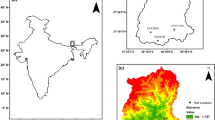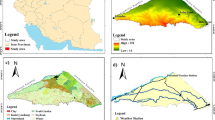Abstract
Although there have been many studies in climate projection and cropping calendar, but a little evidence in relationships with climate change in the southern part of Indonesia, especially in East Nusa Tenggara. East Nusa Tenggara (NTT) Province, a province with consists many islands, typical monsoon climate with low annual rainfall. The aims of this study is to predict potential rainfall that can be used for agriculture, to calculate crop water requirement (especially for rice and corn), and to decide planting schedule for rice and corn during 2016–2020 in Kupang, East Nusa Tenggara Province as the southern part of Indonesia. As the results, for climate projection, temperature during period 2015–2040 will be increased around 0.4 °C, and rainfall will be fluctuated during that period. Data rainfall prediction is used to predict water balance during 2016–2020. Water balance for each beginning of planting season was used as basic to decide planting schedule of rice and corn. The result shows that water potential from rainfall is 838.9 mm year−1. The amount of crop water requirement for rice on December and January (2016–2020) are 605.73 mm per planting season and 611.56 mm per planting season, respectively. Further, crop water requirement of corn (December and January) are 344.78 mm per planting season and 348.19 mm per planting season, respectively. Planting schedule scenarios during 5 year (2016–2020) for rice and corn are dominates in December and January.
Access provided by CONRICYT-eBooks. Download conference paper PDF
Similar content being viewed by others
Keywords
1 Introduction
Rice , the primary staple food for Indonesia’s 250 × 10−6 people, provides seasonal income and employment for a large segment of the country’s rural population. Significant growth in rice production has bolstered rural development since the early 1970’s, but climate change has affected rice production in Indonesia with El Nino/Southern Oscillation (ENSO) events as reported in previous studies [1, 2]. Climate change caused the increased scarcity of and competition for water resources that have changed the planting pattern in Indonesia.
East Nusa Tenggara (NTT) is known as a province with typical monsoon climate with low annual rainfall . Increasing population and reducing arable area have increased the challenges to raise rice productivity. In addition, climate change has affected on any sectors including agriculture. Changes in rainfall patterns and extreme climate events such as El Nino and La-Nina are some indicators of climate change that can be felt directly current time. It caused by increasing the average air temperature by increasing concentrations of greenhouse gases in the atmosphere. Climate change also has affected on the water resources for rice farming [3]. Sustainability of rice farming is depending on water resource, when its scarcity became increasing due climate changes [4]. Water saving technology for rice farming is essential.
Based on Statistical Bureau of Republic Indonesia [6], productivity of maize in NTT influenced by El Nino and La Nina events. During 2012–2015, productivity of maize was decreased due to El Nino events. Aims of this study is to predict potential rainfall that can be used for agriculture, to calculate crop water requirement (especially for rice and corn), and to decide planting schedule for rice and corn during 2016–2020 as one of the southern part of Island in Indonesia.
2 Methods
2.1 Study Area
Our study area is East Nusa Tenggara Province which is located in 8° to 12° S and 118° to 125° E (Fig. 1). East Nusa Tenggara Province consists 21 districts and 285 sub districts with area 47,349.90 km2. Climate condition is typical monsoon climate with low annual rainfall .
Map of East Nusa Tenggara Province, Indonesia [5]
2.2 Data
Precipitations data (2001–2015) was collected from the Bureau of Climatology and Geophysics, Republic of Indonesia. Rice , rain-fed rice, and maize productivity of East Nusa Tenggara Province from 2001 to 2015 were collected from Regional Development Institution of East Nusa Tenggara Province [7] and Meterological, Climatological and Geophysical Agency of Republic Indonesia [8].
2.3 Data Analysis
2.3.1 Analysis of Rainfall
Run test and Rescaled Adjusted Partial Sums (RAPS) were used in this study. Time series data of rainfall during 15 year (2001–2015) have been analyzed for their consistency data through standard deviation and cumulative deviation test. Then. Thomas-Fiering equation was used to predict rainfall. For this analysis, model calibration is used to get high correlation value of generated data and observation data. Clarke [9] stated that Thomas-Fiering equation can be determined by calculate mean value of monthly rainfall, deviation standard, correlation coefficient, slope regression equation, and random variant of normal distribution. Thomas-Fiering regression equation was follow:
where xi and xi + 1 are generated hydrological variables during the i’th and i + 1’st month. respectively; xj and xj + 1 are mean of the hydrological variable in months j and j + 1; bj is regression coefficient ; ti is a random normal variable with zero mean and unit variance; sj + 1 is standard deviation of the hydrological variable in the j + 1’st month; and rj is correlation coefficient between the hydrological variables in months j and j + 1.
2.3.2 Model Validation
Model validity was used to determine compability of theoretical distribution model with the observed data. The t test paired data was used for validation of rainfall data in 2006 compared with observed data in 2006. Then the correlation coefficient test (r) at a certain level of trust is used to know the closeness of the relationship between the two data. The correlation coefficient value of r-count is compared with r-table. This test is follow Eqs. 2 and 3.
where n is amount of data and d is data.
Coefficient of correlation is calculate by:
If r count > r table then show the correlation between Xi dan Yi.
2.3.3 Analysis of Crop Water Requirement and Effective Rainfall
Crop water requirement (ETc ) was determined by evapotranspiration (ETo) multiply with crop coefficient (Kc). ETo calculated through Cropwat 8.0. Mean climate data (2001–2015) including maximum and minimum temperature (°C); relative humidity (%); wind velocity (m s−1); and sunshine duration (%) were used to calculate ETo. Crop coefficient (Kc) of rice and corn was different during their growth (Table 1). Effective rainfall also determined through Cropwat 8.0 software from FAO by using prediction data of rainfall (2016–2020).
2.3.4 Analysis of Water Balance and Planting Schedule
Water balance and planting schedule is determined based on ETo and effective rainfall calculation. Planting schedule for rice and corn (2016–2020) during a year is using water balance concept with monthly interval. Water balance will determine surplus and deficit month.
3 Results and Discussion
3.1 Rainfall Prediction
In this study, rainfall prediction is using Thomas-Fiering to predict rainfall during 5 year (2016–2017). Rainfall with high intensity was predicted during rainy season (November to March). Peak of rainy season in Kupang regency were February and March. Rainfall intensity was decreased in October (Table 2).
3.2 Water Balance and Planting Schedule
3.2.1 Crop Water Requirement
Crop water requirement (CWR ) of rice was higher than corn (Tables 3, 4, 5 and 6). Rice is crop with cultivation period about 4 months. In general, planting season in Kupang will starts if available rainfall is about 200 mm per month. Wairata [11] stated that planting season in Kupang was divided into three periods. First planting season was in rainy season (November to February) and main crop was rice. Second season was started from March to June with corn as main crop. However, some area, which has good irrigation system will cultivate rice . Third season was July to October with no crop production .
CWR and effective rainfall was used to determine planting schedule. For 2016–2020, we choosen two different scenarios based on water balance calculation. First scenario was December to March and second was January to April for rice cultivation. The amount of crop water requirement for rice on December and January (2016–2020) are 605.73 mm per planting season and 611.56 mm per planting season, respectively. Further, crop water requirement of corn (December and January) are 344.78 mm per planting season and 348.19 mm per planting season, respectively (Tables 3, 4, 5 and 6).
3.2.2 Water Balance
Water balance of rice and corn cultivation was derived from effective rainfall and CWR. For rice cultivation, will have deficit about 28.96 mm year−1 if planting time was start in January 2016. However, in other planting schedule have no problem with water availability from rainfall (Table 7). In case of corn cultivation, there was also have no problem with water (Table 8). Effective rainfall during planting season both in rice and corn was adequate.
3.2.3 Planting Schedule
Planting schedule in Kupang Regency commonly was in November, but as mention before, this study shows different result. Based on water balance prediction, planting schedule was change. Planting schedule starts from December and January (Figs. 2, 3, and 4).
4 Conclusion
This study present rainfall prediction during 5 year (2016–2020) shows that water potential from rainfall is 838.9 mm year−1. The amount of crop water requirement for rice on December and January (2016–2020) are 605.73 mm per planting season and 611.56 mm per planting season, respectively. Further, crop water requirement of corn (December and January) are 344.78 mm per planting season and 348.19 mm per planting season, respectively. Based on water balance analysis, planting schedule scenarios during 5 year (2016–2020) for rice and corn are dominates in December and January.
Abbreviations
- ENSO:
-
El Nino/Southern Oscillation
- CWR:
-
Crop water requirement
References
IPCC. Climate change 2013: the physical science basis. Intergovernmental Panel on Climate Change; 2013.
Nugroho BDA, Prima ODA, Kanno H, Sameshima R, Fujii H, Lopez LCM. Relationships between global climate indices and rain-fed crop yields in highland of South-Central Java. J Geogr. 2013;122(3):434–47.
De Silva CS, Weatherhead EK, Knox JW, Rodriguez-Diaz JA. Predicting the impacts of climate change – a case study of paddy irrigation water requirements in Sri Lanka. Agr Water Manag. 2007;93(1–2):19–29. https://doi.org/10.1016/j.agwat.2007.06.003.
Nugroho, BDA. Fenomena Iklim Global, Perubahan Iklim dan Dampaknya di Indonesia [Global climate phenomena, climate change and its impacts in Indonesia]. Yogyakarta: UGM Press; 2016. (in Bahasa Indonesia).
Australian National University. Maps online ANU college of Asia & the Pasific. http://asiapacific.anu.edu.au/mapsonline/base-maps/nusa-tenggara-timur-boundaries. Accessed 8 June 2018.
Statistical Bureau of Republic Indonesia. Indonesia dalam angka, Provinsi East Nusa Tenggara [Indonesia in number, East Nusa Tenggara Province]. 2016. https://www.bps.go.id/subject/53/tanaman-pangan.html#subjekViewTab3. Accessed June 2017. (in Bahasa Indonesia).
Regional Development Institution of East Nusa Tenggara Province. Studi tentang perubahan iklim di Nusa Tenggara Timur.[Study on climate change in East Nusa Tenggara]. 2017. http://bappeda.nttprov.go.id/index.php/item/kajian-perubahan-iklim-di-ntt. Accessed 23 Mar 2017. (in Bahasa Indonesia).
Meteorogical, Climatological and Geophysics Agency of Republic Indonesia. Klasifikasi iklim [Climate classification]. 2017. http://www.klimatologibanjarbaru.com/klimatologi/publikasi/keterangan-oldeman/#kriteria Accessed 23 May 2017. (in Bahasa Indonesia).
Clarke RT. Mathematical models in hydrology. Rome: FAO of The United Nations; 1973.
Doorenbos J, Pruitt WO. Crop water requirements. FAO irrigation and drainage paper No. 24. Rome: Food and Agriculture Organization of the United Nations; 1977.
Wairata EJ. Tesis tentang sistem penentuan prioritas tanam di Kota Kupang berbasis analytical hierarchy process (AHP) [Planting schedule uding analytical hierarchy process (AHP) in Kupang]. Salatiga: Universitas Kristen Satya Wacana; 2012. (in Bahasa Indonesia).
Author information
Authors and Affiliations
Corresponding author
Editor information
Editors and Affiliations
Rights and permissions
Copyright information
© 2018 Springer Nature Switzerland AG
About this paper
Cite this paper
Nugroho, B.D.A., Arif, C., Maftukhah, R. (2018). Cropping Calendar Scenario Based on Climate Projections Against Regional Climate Change in the Southern Part of Indonesia. In: Sukartiko, A., Nuringtyas, T., Marliana, S., Isnansetyo, A. (eds) Proceeding of the 2nd International Conference on Tropical Agriculture. Springer, Cham. https://doi.org/10.1007/978-3-319-97553-5_2
Download citation
DOI: https://doi.org/10.1007/978-3-319-97553-5_2
Published:
Publisher Name: Springer, Cham
Print ISBN: 978-3-319-97552-8
Online ISBN: 978-3-319-97553-5
eBook Packages: Biomedical and Life SciencesBiomedical and Life Sciences (R0)








